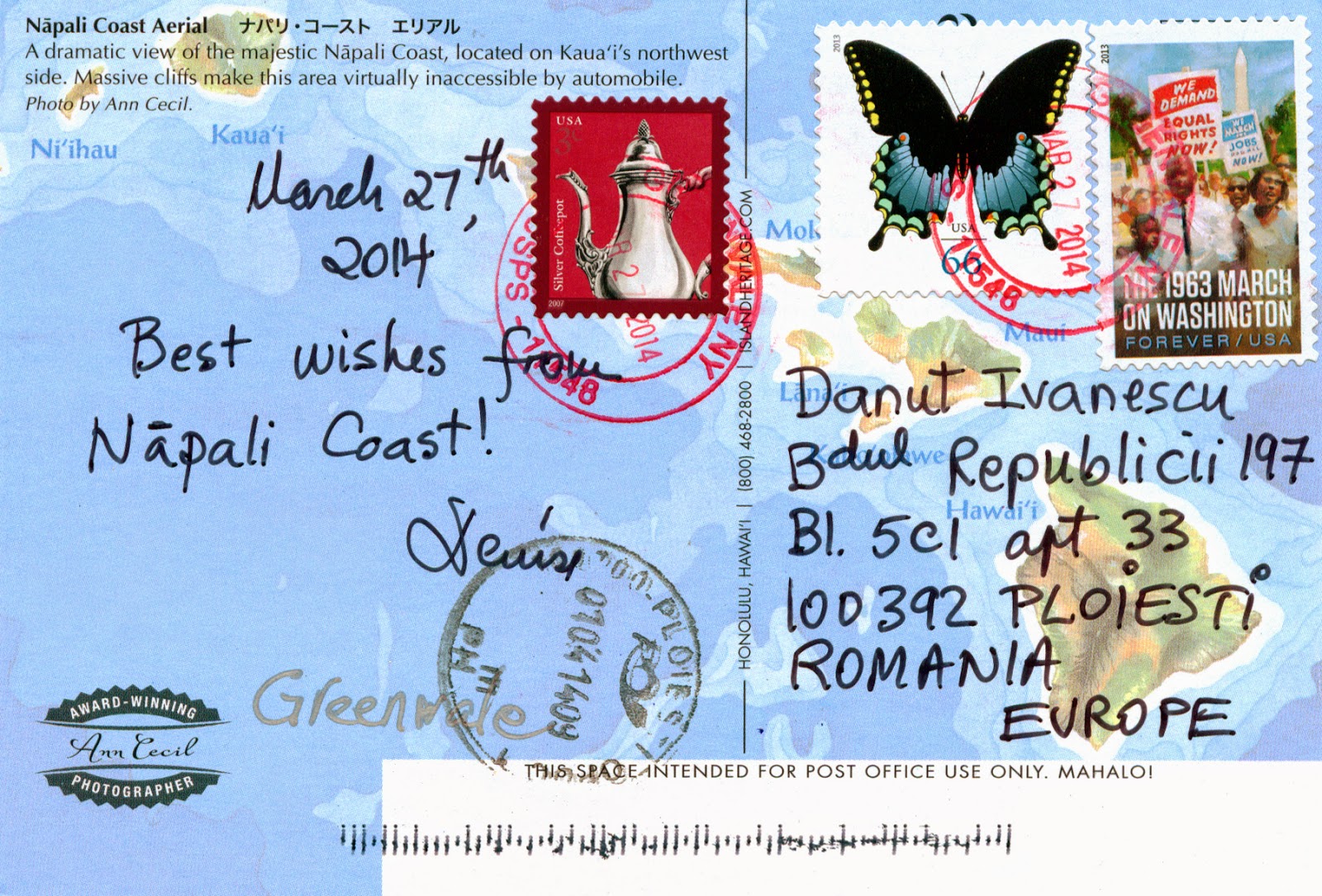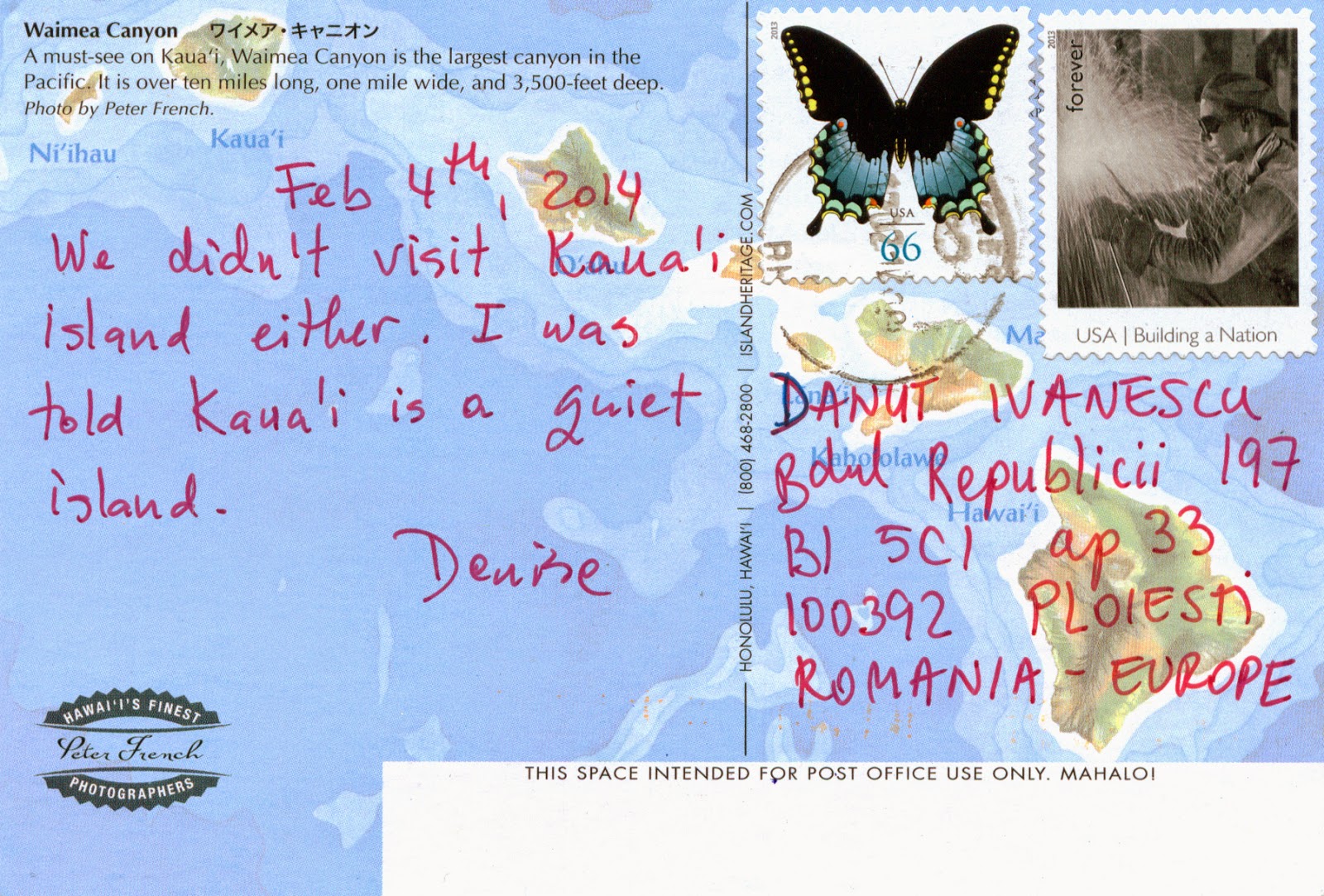 |
| 1047 Kauai - Nā Pali Coast State Park |
Posted on 06.04.2014, 15.08.2015
Kauai, the oldest and northernmost island in the Hawaiian chain, the fourth largest of the archipelago, was formed by the passage of the Pacific plate over the Hawaii hotspot. Discovered by Captain James Cook in 1778, it was one of the last islands which joined the Kingdom of Hawai'i, during the reign of King Kamehameha. Draped in emerald valleys, sharp mountain spires and jagged cliffs, it is surnamed The Garden Isle. Kauai's most striking geographic feature is the Nā Pali Coast State Park, located in the center of the rugged 26km along the northwest side of the island. Result of millions of years of wind and water erosion, it stretch southwest starting at Ke'e Beach until the Polihale State Park, and is formed of high cliffs (na pali), which rise until 1.200m hight along the shoreline, but also of green valleys, towering waterfalls and hidden sea caves. These cliffs can only be seen from the sea, by air or by hiking the Kalalau Trail, which runs 18km and crossing five major valleys before reaching Kalalau Beach at the base of Kalalau Valley.
 |
| 1048 Kauai - Kalalau Valley |
Actually the Nā Pali Coast State Park was formed to protect the Kalalau Valley, surrounded by lush cliffs more than 610m high. The valley bottom is broad and relatively flat, with an accessible region about 3km long and almost 1km wide. The abundant sun and rain provides an ideal environment for flora and fauna. Many native Hawaiians lived in the valley into the 20th century, farming taro from a vast complex of terraced fields. Unfortunately these terraced gardens are being threatened and destroyed by the introduced and invasive trees, which created an extensive underground root network which invaded the rock walls of the terraces. The valley is home to many rare species, including the endangered plant Dubautia kalalauensis which was named for the valley and is found nowhere else in the world. Other endemics include the endangered Schiedea attenuata.
 |
| 1049 Kauai - Waimea Canyon |
To the east of the Nā Pali Coast State Park is the Hono O Nā Pali State Natural Reserve. Hiking trails and hunters roads have access to the sharp ridges from Koke Road in Waimea Canyon (16km long and up to 900m deep), also known as the Grand Canyon of the Pacific. Waimea is Hawaiian for "reddish water", a reference to the erosion of the canyon's red soil. It has a unique geologic history, because it was formed not only by the steady process of erosion, but also by a catastrophic collapse of the volcano that created Kauai. Roughly 4 million years ago, while Kauai was still erupting, a portion of the island collapsed, forming a depression, which then filled with lava flows. In the time since, rainwater from the slopes of the island's central peak (Mount Waiʻaleʻale, which is among the wettest places on earth) have eroded Waimea Canyon along one edge of the collapse.
 |
| 1050 Kauai - Polihale Beach |
Polihale State Park is a remote wild beach on the western side of the island, on the south of the Na Pali Coast mountain ridges, and even if is several kilometers long, offers safe swimming only in the area known as Queen's Pond, a shallow pond with a sandy bottom surrounded by a protecting reef, located at the southern end. It is kilometers away from the town of Kekaha and can only be reached via a dirt sugarcane road. Sand dunes along the beach can reach heights nearing 30m. South of Queen's Pond is Barking Sands Beach, also known as Keonekani o Nohili (The Sounding Sands of Nohili). If one walks over the sand here or takes two handfuls of sand in each hand and slaps it together, a sound is produced. This phenomenon occurs due to the formation of the individual sand grains, each of them having small holes in it, and the sound is produced within these small cavities through the vibrations that occur when the sand is pushed together.
 |
| 1051 Kauai - Kīlauea Point National Wildlife Refuge |
Kīlauea Point National Wildlife Refuge is located on the northwest coast of the island, established in 1985 to preserve and enhance seabird nesting colonies. On Kīlauea Point, a narrow, lava peninsula, is located Kīlauea Lighthouse, dedicated in 1913, and built in a Classical Revival architecture style out of reinforced concrete. The tower is a slightly tapering cylinder about 16m high. The lens one of only seven second-order Fresnel lenses remaining in a lighthouse in the US. Barbier, Bernard, and Turenne manufactured the lens in Paris, France. The 4,100kg lens floated on mercury and compressed air, and was rotated by a system of pulleys powered by weights that needed to be reset by an operator every 3.5 hours. The station was manned until 1974 when it was automated. In February 1976 the light was moved to a nearby smaller tower and the tower was sealed.
 |
| 1825 Kauai - Hanalei River |
The Hanalei River flows north from the eastern slopes of Mount Waiʻaleʻale for 25km, until it reaches the Pacific Ocean at Hanalei Bay as an estuary. It encompasses areas of the highest recorded rainfall on the planet and plunges precipitously from its headwaters at 1,100m above sea level. The lower, flatter portion of the river flows by Hanalei National Wildlife Refuge and many taro farms. The Hanalei River provides habitat for a number of amphidromous species, including gobies (5 native varieties), two native species of crustacean, the hīhīwai (Neritina granosa, an edible snail), and in its upper reaches, a threatened species of highly adapted snail (Newcomb's snail, Erinna newcombi)..
About the stamps
On the postcard 1047
The first stamp, depicting a Silver Coffeepot (3c / 2005), is part of the definitives series American Design (2002-2007), about which I wrote here. The second, depicting Spicebush Swallowtail, is part of a definitive series with butterflies, about which I wrote here. The third is the last of three stamps issued as part of a civil rights series commemorating courage, strength and equality in America, about which I wrote here.
On the postcard 1048
The first stamp is the one issued in 2013 for celebrating Kwanzaa, about which I wrote here. The second, depicting Spicebush Swallowtail, is part of a definitive series with butterflies, about which I wrote here.
On the postcard 1049
The first stamp, depicting Spicebush Swallowtail, is part of a definitive series with butterflies, about which I wrote here.
The second stamp is part of a series which honors America’s industrial workers, named Building a Nation and issued on August 08, 2013. "Stamps are like a miniature American portrait gallery," said Labor Secretary Perez. "They are an expression of our values and a connection to our past. That’s why it’s so fitting that that this series depicts Americans at work. These iconic images tell a powerful story about American economic strength and prosperity. These men and women and millions like them really did build a nation." The 12 stamps features black-and-white photographs of early 20th-century industrial workers (eleven of them was taken by photographer Lewis Hine, and one, the female welder, by Margaret Bourke-White):
• an airplane maker - It's on the postcard 1072
• a derrick worker on the Empire State Building - It's on the postcard 1293
• a millinery apprentice - It's on the postcard 1290
• a laborer on a hoisting ball at the Empire State Building - It's on the postcard 1035
• a linotyper in a publishing house - It's on the postcard 1280
• a welder on the Empire State Building - It's on the postcard 1049
• a coal miner - It's on the the postcard 1040
• riveters on the Empire State Building - It's on the postcard 1051
• a powerhouse mechanic - It's on the postcard 1288
• a railroad track walker - It's on the postcard 1284
• a textile worker - It's on the postcard 1825
• a crew member guiding a beam on the Empire State Building - It's on the postcard 1040
On the postcard 1050
The first stamp was issued on January 16, 2014, to celebrate the Lunar New Year (Year of the Horse, 31 January 2014 - 18 February 2015). It features drums and a small horse in the upper left corner. The stamp was illustrated by Kam Mak.
About the second stamp, featuring a portrait of George Washington, I wrote here.
On the postcard 1051
The first stamp, depicting Spicebush Swallowtail, is part of a definitive series with butterflies, about which I wrote here. The second, depicting a riveters on the Empire State Building, is also part of the series Building a Nation, about which I wrote before.
On the postcard 1825
The first stamp, depicting Spicebush Swallowtail, is part of a definitive series with butterflies, about which I wrote here. The second stamp is part of the series Building a Nation, about which I wrote above.
This is a post for Sunday Stamps #165, run by Viridian from Viridian’s Postcard Blog. The theme of this week is: anything you wish. Click on the button to visit Viridian’s blog and all the other participants.
References
Kauai - Wikipedia
Kaua'i - Hawaii's Official Tourism Site
Nā Pali Coast State Park - Wikipedia
Kalalau Valley - Wikipedia
Waimea Canyon State Park - Wikipedia
Polihale State Park - Wikipedia
Polihale State Beach Park - Hawaii Travel Guide
Kilauea Light - Wikipedia
Sender 1047-1051, 1825: Denise
1047, 1048: Sent from Greenvale (New York / United States), on 27.03.2014
Photo: Ann Cecil
1049: Sent from Greenvale (New York / United States), on 04.02.2014
Photo: Peter French
1050: Sent from Greenvale (New York / United States), on 25.03.2014
Photo: Ann Cecil
1051: Sent from Greenvale (New York / United States), on 04.02.2014
Photo: Michael Paravano
1825: Sent from Greenvale (New York / United States), on 04.02.2014
Photo: David Boynton











Beautiful cards and great stamps. Love the Building a Nation series.
ReplyDeleteMe too. Very good idea and well implemented.
DeleteStunning cards, makes me want to jump on a plane and visit. I remember reading that the invasive tree species you mention were from seeds brought in on hiking boots. I'm always envious whenever I see those Building A Nation stamps on a postcard.
ReplyDeleteAnd I have the whole series.
Delete